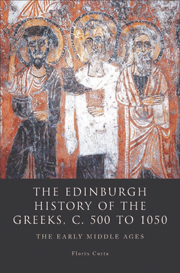Book contents
- Frontmatter
- Contents
- List of Illustrations
- List of Tables
- Acknowledgements
- Series Editor's Preface
- Introduction
- 1 The last century of Roman power (c. 500 to c. 620): army, church, and countryside
- 2 Collapse or adaptation? The problem of the urban decline in late antique Greece
- 3 Invasion or inflation? Hoards and barbarians in sixth- and early seventh-century Greece
- 4 Dark-Age Greece (c. 620 to c. 800)
- 5 Revival and expansion (c. 800 to c. 900)
- 6 The beginning of prosperity (c. 900 to c. 1050)
- 7 Early medieval Greece and the Middle Byzantine economy
- 8 Social structures and Byzantine administration in early medieval Greece
- 9 Christianity in early medieval Greece
- 10 Conclusion: the people of early medieval Greece
- Bibliography
- Index
6 - The beginning of prosperity (c. 900 to c. 1050)
Published online by Cambridge University Press: 05 August 2013
- Frontmatter
- Contents
- List of Illustrations
- List of Tables
- Acknowledgements
- Series Editor's Preface
- Introduction
- 1 The last century of Roman power (c. 500 to c. 620): army, church, and countryside
- 2 Collapse or adaptation? The problem of the urban decline in late antique Greece
- 3 Invasion or inflation? Hoards and barbarians in sixth- and early seventh-century Greece
- 4 Dark-Age Greece (c. 620 to c. 800)
- 5 Revival and expansion (c. 800 to c. 900)
- 6 The beginning of prosperity (c. 900 to c. 1050)
- 7 Early medieval Greece and the Middle Byzantine economy
- 8 Social structures and Byzantine administration in early medieval Greece
- 9 Christianity in early medieval Greece
- 10 Conclusion: the people of early medieval Greece
- Bibliography
- Index
Summary
The series of victories against the Arabs obtained in the late ninth century by the Byzantine fleet in the Aegean and Ionian seas was abruptly interrupted after 900 by a number of bold, even spectacular attacks on major cities in Greece. Following an attack on Lemnos in 901, a Syrian fleet commanded by the emir of Tarsos, Damianos, sacked in 902 the city of Demetrias in the Pagasic Bay in Thessaly (Theophanes Continuatus, in Bekker 1838: 365; John Kaminiates, The Capture of Thessaloniki 14). Shortly after that, the protospatharios Petronas, who had been commissioned by Emperor Leo VI to take temporary charge of the defence of Thessalonike, arrived in that city from Constantinople with alarming news of an impending Arab attack by a large fleet under the command of Leo of Tripoli (Abū Harith).
He said that fugitives from the hands of those barbarians had arrived and had given the emperor prior information concerning their strategy, to the effect that they were now concentrating all their energies for a projected attack on the city, since they had been assured by many of those whom they had previously defeated that it was practically unwalled on the seaward side and would be an easy target for a seaborne attack. Once these dreadful tidings had been received, confused and panic-stricken rumours were rife throughout the city.
John Kaminiates does not give any details as to the nature of the rumours, but historians have speculated that Leo of Tripoli, who had initially planned to attack Constantinople, may have been invited to do so by a conspiracy against Emperor Leo VI organised by Andronikos Dukas and Eustathios Argyros in cooperation with Patriarch Nicholas Mystikos (Jenkins 1948; Farag 1989: 138).
- Type
- Chapter
- Information
- The Edinburgh History of the Greeks, c. 500 to 1050The Early Middle Ages, pp. 166 - 208Publisher: Edinburgh University PressPrint publication year: 2011



